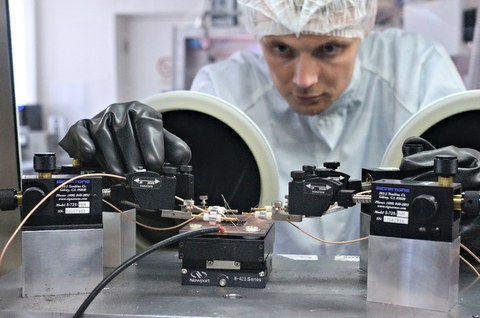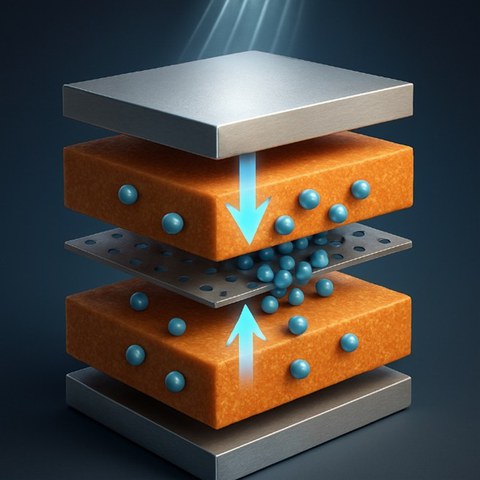Sep 12, 2025
Innovative detector research: New organic phototransistor detects and stores weak light

Jonas Schröder is measuring an organic photo-transistor under inert atmosphere (nitrogen) in a glovebox.
Researchers at the Institute of Applied Physics at TUD Dresden University of Technology, the Centre for Technology Development at the German Centre for Astrophysics (DZA) in Görlitz, and TH Mittelhessen have jointly developed a new organic phototransistor. It can detect weak light particularly efficient, and store it simultaneously. This unique approach marks the beginning of a successful cooperation between the institutions, opening up promising opportunities in detector research and setting a benchmark for the future of modern light-sensing technology. The results have now been published in the renowned journal Nature Photonics.
Jonas Schröder, lead author and member of the “Organic sensors and solar cells (OSENS)” research group at the Institute of Applied Physics (IAP) at TUD, is delighted with the research results: "Our transistors enable particularly compact light sensors, as they do not require complex external circuits. An essential feature of the novel device is the integrated memory mechanism. It opens up a wide range of possible applications, e. g. in multispectral imaging or in cost-efficient sensor systems that work reliably even at low light intensities. This represents a significant advance for future imaging sensor architectures."
Photodetectors are a key component in a vast variety of contemporary technologies. They are used in cameras, sensor-controlled driving systems, security systems, and even space detectors, among other things. An interdisciplinary research team from Dresden, Görlitz, and Gießen has now presented a completely new technology for photodetectors. For the first time, the scientists are using so-called OPBTs (organic permeable base transistors), a special class of vertical transistors based on organic semiconductors. These unique devices operate with high energy-efficiency. Moreover, they can be applied in ultra-thin films and be easily customized to specific needs.

Novel photodetector that combines detection and storage in a very compact device, making it ideal for high-resolution matrix image sensors.
Dr. Johannes Benduhn, head of the OSENS group and also of the “Detector Research” group at the German Centre for Astrophysics (DZA), emphasizes the innovative nature of the development: "We demonstrated that these transistors amplify the signal directly within the device, not through conventional high-field charge carrier avalanches, but through controlled charge storage in the transistor structure. This innovation greatly simplifies, both the manufacturing and operating processes of light sensors, and thus enables new operating modes that are particularly suitable for the detection of very weak light signals, e. g. for astrophysical applications." Thanks to their novel structure, OPBTs achieve exceptionally high light sensitivity with responsivities of up to 109 A/W (amperes per watt). This value is far higher than that of typical organic photodetectors. In addition, the specific selection of materials used allows the wavelengths (light colors) to which the devices are particularly responsive to be adjusted. Light ranges such as UV or infrared light, which the human eye cannot perceive, are thus made visible.
The technology is currently being further developed as part of the OPTICUS validation project. The aim is to increase the technology readiness level (TRL) and identify specific fields of application.
Original publication:
Jonas Schröder, Amric Bonil, L. Conrad Winkler, Jan Frede, Ghader Darbandy, Juan Wang, Karl Leo, Hans Kleemann, and Johannes Benduhn. Organic permeable base transistors for high-performance photodetection with photo-memory effect. Nature Photonics, DOI: https://doi.org/10.1038/s41566-025-01740-y
Background:
Organic Sensors and Solar Cells (OSENS) Working Group
Sensors are key elements of future smart electronics and are widely used in almost any area of technology. In the OSENS group, researchers with backgrounds in physics, material sciences, and engineering collaborate closely on a broad range of topics. Their skills ranges from device physics and development, over materials development to the fundamental photophysics of novel semiconductors. The group is based at the Chair of Optoelectronics (Prof. Karl Leo) and is headed by Dr. Johannes Benduhn.
Center for Technology Development at the German Centre for Astrophysics
Detector development is a central scientific pillar at the German Centre for Astrophysics (DZA). It enables the development of high-precision and energy-efficient technologies that are to be used in astrophysical research for the detection and analysis of extremely weak cosmic signals, among other things. The “Detector Research” working group is part of the Centre for Technology Development/Zentrum für Technologieentwicklung ZTE at the DZA, lead by Prof. Dr. Martin Roth. Until its establishment, the DZA is in a development phase, financed as part of a project grant to the TUD Dresden University of Technology and the German Electron Synchrotron DESY from the Federal Ministry of Research, Technology, and Space (BMFTR).
Contacts for media inquiries:
TUD Dresden University of Technology:
Nicole Gierig
Tel.: +49 351 463 39504
Email:
German Centre for Astrophysics:
Sarah Stötzner
Tel.: 0152 224 701 85
Email:
Scientific contacts:
Jonas Schröder
Research Associate, Chair of Optoelectronics
Institute of Applied Physics (IAP)
TU Dresden
Tel.: +49 351 463 43350
Email:
Dr. Johannes Benduhn
Head of the “Organic Sensors and Solar Cells” Working Group (IAP, TUD)
Head of the “Detector Research” Working Group at the Center for Technology Development (ZTE) at the German Center for Astrophysics (DZA)
Tel.: +49 351 463 36446
E-mail:
